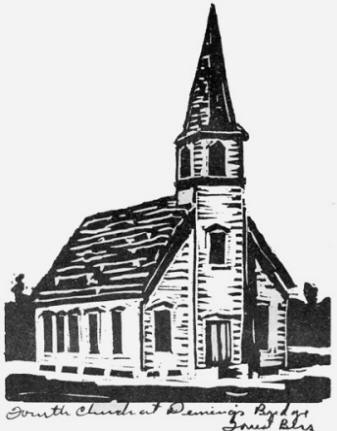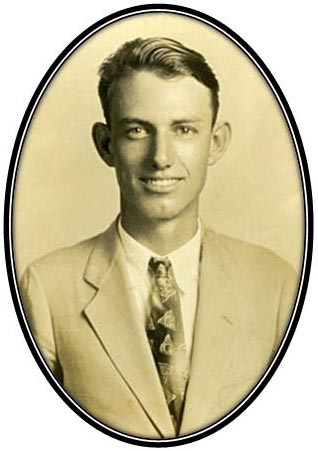|
|||
|
Forrest Clemenger Bess lived an extraordinarily simple life during most of his residency in Matagorda County, yet this man could never be described as simple. Indeed, complex, provoking, visionary, enigmatic eccentric, egocentric, intelligent, sensitive, kind, generous, contradicting, cantankerous, perceptive and witty are but a few of the descriptive adjectives used by those who knew him to profile him. Forrest, the first born son of Arnold “Butch” and Minta Lee Farrell Bess, was born on October 5, 1911, in Bay City, Texas. At the time his parents were living in Clemville, Texas, where Butch was an oil driller, and Forrest spent his childhood there along with his only sibling, a brother, Milton. Forrest began drawing and sketching as a child and must have known then that he would someday become an artist. His extraordinary hand and eye coordination, coupled with his sensual use of color made his early paintings both accurate and artistic. Forrest attended Bay City High School where he played football and, as class salutatorian, was graduated in the class of 1929. He entered Texas A & M University as an architecture major, but transferred to The University of Texas at the end of his sophomore year. Forrest’s studies at The University of Texas turned to the metaphysical and the study of Greek Mythology, and he soon dropped his pursuit of architecture. At the end of his junior year he returned to Bay City where he took commissions for paintings and roughnecked in nearby oil fields to earn sufficient funds to enable him to travel to Mexico for serious study of art. This lifestyle became a pattern for several years; staying in Mexico until the pesos ran out and returning to Texas to “make more pesos” and then back again to Mexico. Forrest had his first one-man show at the Bay-Tex Hotel in 1937, and in 1939, the Witte Museum in San Antonio was the side of the second. The onset of World War II steered him into the Army Corp of Engineers where he advanced to the rank of Captain. As an artist, he was assigned to the camouflage department where he was commended for his developmental work in that field. During that time he suffered a mental breakdown because of his inability to reconcile the conflicting aspects of his personality. At the war’s end and with an honorable discharge from the service, he opened a studio in San Antonio where he became accepted as a serious artist. Forrest left San Antonio in 1947 to live with his parents in their Chinquipin bait camp and began to draw and paint in symbols which were inspire by his dreams. He kept his “black book: at his bedside to hastily record the symbolism of his dreams when he awoke. This marked the turn of his career toward “Visionary Art.” Old friends as well as new often traveled by boat to his camp to visit him, see his latest works, and while away the time discussing his latest “far out” theories. Forrest’s friends were lifelong, accepting his idiosyncrasies and loving him for his individuality. Although few local people cared for or understood his abstractions and symbolistic paintings which were often crudely rendered and framed in driftwood, in New York his work began to be recognized and acquired by astute collectors. Betty Parsons, a New York and Gallery owner, recognized his individualism and unique style as work set apart from the norm and encouraged him to send his work to her, which he did until he ceased to paint. Unfortunately, Forrest was not overly productive and had to rely on his bait camp for subsistence. Forrest claimed correspondence with Carl Jung and maintained an extended correspondence with Dr. John Money, professor of medical psychology in the department of Psychohormonal Research at Johns Hopkins. This collection of correspondence, along with other correspondence and slides of his paintings, is housed in the Smithsonian American art Archives, Texas Chapter. Forrest held a significant number of one man shows at important museums throughout the United States. His work was included in the Corcoran Gallery of Art in Washington, D. C. in 1939, and in the Texas Fine Arts Commission exhibit at the Hemisfair during the Texas Bicentennial Celebration in 1976. The new De Menil Museum of art featured Bess’ work in a show commemorating the Texas Sesquicentennial celebration. Although he never received more than two hundred dollars for a painting during his lifetime, he predicted that after his death his works would become famous and in demand. Forrest’s predictions appear to be on target. Since his death he has been featured in a one man show at the Whitney Museum of American Art in 1981 as wel as in other important shows. In keeping with his life of symbolism, Forrest Clemenger Bess departed this life in Bay City on the eleventh day of the eleventh month in the year of 1977 at the age of sixty-six. Historic Matagorda County, Volume II, pages 26-37
|
|||
|
The renowned artist had lived in this area most of his life with a good deal of his life spent living in an old bait camp at Chinquapin, until 1961 when Hurricane Carla destroyed the entire area. Bess reportedly began drawing in grammar school and in later years as an architecture student at Texas A & M and the University of Texas in 1957 he made the highest grade ever in the architectural history course that had been recorded to that time. After serving in the armed forces Bess traveled extensively between 1934-40 before returning to run his father’s bait camp at Chinquapin. During his travels the artist studied under artists in Mexico and several of his paintings depict the rooftops in Tasco, another the Acapulco Bay, and still another of Laguna Beach. During these years Bess’ one-man shows were at the Witte Memorial Museum and the Museum of Fine Arts in Houston (1938). After his return to Chinquapin, Bess became known for his revolutionary approach to art and created considerable interest in art circles with symbolisms on canvas which characterized his dreams. In one visionary canvas (Prophecy) he accurately predicted the shape and performance of Sputnik several years before he Russians invented the spacecraft. Several of the people in area who own his paintings today and who knew him at Chinquapin, agree that Bess was a widely read man in spite of his living like a hermit at his bait camp across the channel. Bess had said that he developed an avid interest in the modern psychologist Carl Gustav Jung. He mailed off several questions he had about Jung’s book “Modern Man in Search of His Soul” and received an answer. Their correspondence continued through the 1950’s until Jung’s death in 1961. Exhibits of Bess’ visionary works continued with one-man shoes at the Dallas Museum, Philbrook Musuem, Andre Emmerich in Houston (1958), Contemporary Art Musuem in Houston (1962) and in Everson Museum of Art in Syracuse, New York (1974). One of his primary backers in New York was Betty Parsons, whose 57th Street gallery had one-man shows in 1949, 1954, 1957, 1959, 1962 and 1967. Today, Bess’ work is included in the private collections of the Houston Museum, Meyer Schapito and Joseph DeMenil, as well as those of Stanley Marcusa and Bradeis University among others. In 1970 the Art Institute of Chicago informed Bess that 14 of his paintings, belonging to renowned art collector Earl Luekin of Chicago, were willed to the institute. After suffering a period of declining health, Forrest Bess was hospitalized in San Antonio by his brother, until being admitted at Bay Villa in 1974. In March of 1977, the world renowned artist was honored with a one-man show of his paintings by the Art League. It was the first one-man showing on record of Bess’ paintings here since 1936. AT the time he seemed relaxed and friendly in talking about the forces that influenced his work. Services are pending at Taylor Brothers Funeral Home for Forrest Bess whose only survivor is his brother Milton Bess of Corpus Christi. Although Bess leaves this world with only one survivor, his paintings will live on and long the remembered. The Daily Tribune, November 11, 1977 |
|||
|
Twenty-one oils by Forest Bess of Bay City, Texas, are on view at the Museum of Fine Arts of Houston. Mr. Bess was invited by the director of the museum, James Chillman Jr. to exhibit his work. He has been successful exhibitions recently in San Antonio and Lubbock. In 1939 he had a painting accepted for the Corcoran gallery's biennial exhibition in Washington, D. C. In 1938 the same painting was awarded honorable mention in the second annual exhibit of artists of Southeast Texas held at the Houston museum. Born in Bay City Mr. Bess is 29. He was born in Bay City. He is scheduled to leave soon for Virginia, where he will do camouflage for the next three years for the United States government. He has enlisted in the engineering corps. Mr. Bess received most of his art training at Texas A. & M college and the University of Texas. He later studied under the English artist Richard Carline, and at the Academia de San Carlos in Mexico City. His desire to paint grew out of his study of Greek mythology. His paintings are in Gallery E of the museum and will be view through Sunday, Feb. 16. The museum is open until 10 p. m. every Wednesday night.--Houston Post.
Palacios Beacon, February 13, 1941 |
|||
|
|||
|
|||
|
|


 Forrest Bess, whom some have referred to as “the only true artist of
Texas,” died Thursday afternoon at the Bay Villa Nursing Home at the
age of 65.
Forrest Bess, whom some have referred to as “the only true artist of
Texas,” died Thursday afternoon at the Bay Villa Nursing Home at the
age of 65.